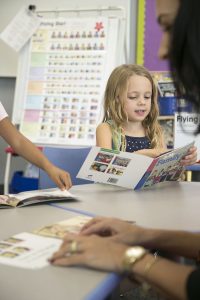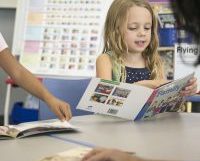 When it comes to high-frequency words, context is key in Guided Reading texts!
When it comes to high-frequency words, context is key in Guided Reading texts!
The use of high-frequency words in Guided Reading texts offers young readers the opportunity to learn these words as part of a wider reading process.
Examples of High-Frequency Words
When developing readers learn these words, such as he, she, you, I, ask, is, but, the, have, and good in context, they learn to recognize these words by sight.
This supports the child to become confident, accurate, and fluent readers.
Teaching to Read Patterns
A singular sentence pattern throughout a book enables students to rely on meaning and structure cues. As they read and learn high-frequency words in context, their graphophonic cueing system is developing. Thoughtfully crafted Guided Reading texts are very helpful. They encourage students to recognize and use high-frequency words in a pattern.
How Guided Reading Creates Meaning
Using known patterns with high-frequency words enables students to “get a run-up” to new and unfamiliar words. During Guided Reading lessons, teachers notice if students are using high-frequency words to “anchor” their reading of a sentence. When a student reads the word “is”, their finger is actually under the word “is”. This demonstrates anchoring.
Words create meaning. Using high-frequency words as an anchor to read with accuracy and comprehension reinforces that meaning. Students who are just saying the words accurately need to understand that reading is about making sense of text.
Guided Reading using High-frequency words in a variety of sentence patterns. This helps the child understand that words do create meaning.
The Importance of a Variety of Sentence Patterns
Teachers whose students are reading in Level A, B, and C texts are often concerned that students simply memorize the sentence. The challenge for teachers is to ensure that students are learning to recognize and use high-frequency words.
During Guided Reading, they should encounter these words in a variety of sentence patterns. This experience helps bring the student's attention to the words, rather than rely exclusively on the pattern.
For example, imagine students only see the word “Here” at the beginning of a sentence. This experience might not provide them with the flexibility to recognize “here” without it beginning with a capital letter. In addition, they may not understand that the word might occur in a different place in a sentence.
Paired Texts
Flying Start to Literacy™ pairs books based on the concept, with each pair using the same high-frequency words. However, each text uses these words in a different sentence pattern. For example, one text might say “Here is my cat,”. The paired text says, “My cat is in here.”
Using high-frequency words in Guided Reading helps children get to know these words and using paired texts with varied sentence patterns helps give meaning to the words. Debra Crouch.

